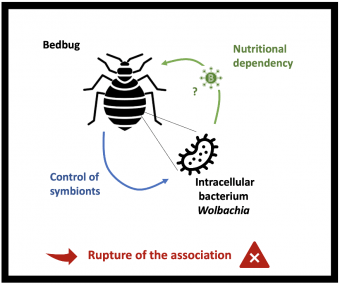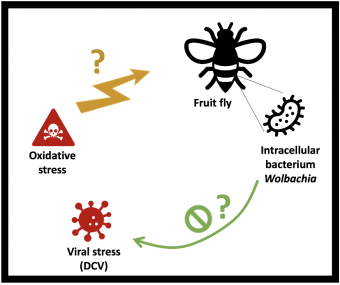
COEVOL Multi-Scale Coevolution
Evolutionary Genetics of Interactions Group
Kremer Natacha
Chargée de recherche
CNRS
Research interests
The goal of my research is to bring an evolutionary perspective to the study of symbiosis, through the understanding of molecular interactions between partners.
Animals live in symbiosis with controlled bacterial communities in contrasting and changing environments. Symbionts can impact the phenotype of their host positively (e.g., by providing nutrients or protecting their host from pathogens) or negatively (by imposing a fitness cost). These partner interactions evolve in response to different selection pressures, making the associations dynamic along the continuum between parasitism and mutualism, and may also vary the degree of dependence between partners. I am particularly interested in the evolution of these symbiotic associations in response to different selection pressures, and in characterizing the molecular mechanisms underlying these changes.
Recent projects
Understanding the interactions between the bedbug and its microbiota, to control its populations by breaking the symbiotic association
Funding Pack Ambition Recherche (région Auvergne Rhône-Alpes) 2019-2024 / SymBed Project/ Collaboration with BF2i and IZInovation / PhD Marius Poulain and Raphaël Jorge.
Funding ANR PRC 2021-2025 / FBI Project / Collaboration with BF2i and LECA.

Bedbugs have increased significantly over the last ten years, mainly due to the increase in human migration and resistance to insecticides. In the short term, the study of resistance determinants (project of Julien Varaldi / Jean-Philippe David) will allow to target the use of insecticides. In parallel, we are studying the interactions between the bedbug Cimex lectularius and its obligate bacterium Wolbachia in order to break the symbiotic association and control bedbug populations by alternative methods to pesticides. Indeed, Wolbachia wCle bacteria synthesize B vitamins that are necessary for the development and fertility of bedbugs. Using transcriptomics, metabolomics and microscopy approaches, we are studying in detail the interactions between the insect and its nutritional symbionts, in order to identify molecular mechanisms involved in the regulation of bacterial density and in the dependence of the bedbug on its symbiont.
Rapid Evolution of symbiotic interaction in response to stress
Funding JCJC ANR 2017-2021 / RESIST Project / PhD Alexis Bénard

Symbionts can promote or constrain rapid host adaptation to environmental changes. In response to global changes (temperature, precipitation; air, water and soil quality; biological invasions...) and to anthropization (intensive agriculture; urbanization...), it is therefore important to study the impact of these changes at the holobiont scale, i.e., the host and its microbial communities. In the RESIST project, we studied more precisely: to what extent do stresses associated with the presence of pesticide (paraquat) and/or virus (DCV) impact flies of the genus Drosophila melanogaster, directly or indirectly via an impact on their Wolbachia symbionts? How does the symbiotic association evolve and more particularly if the presence of Wolbachia allows a rapid adaptation to these stresses? And what molecular and metabolic mechanisms are involved in the response to viral and/or oxidative stress?
Impact of commensal and endosymbiotic bacteria on viral infection in insects
Funding Labex Ecofect 2017-2019 / ComEndoVir Projet/ Co-PI with F. Leulier (IGFL) / Post-doc Vincent Raquin

The complex relationships between different microbial communities and how these communities can impact their host remain poorly studied. In the ComEndoVir project, we therefore characterized the impact of polymicrobial associations on Drosophila physiology. To this end, we created an artificial holobiont model, composed of two commensal bacteria of the digestive tract (Lactobacillus plantarum and Acetobacter pomorum), the intracellular bacterium Wolbachia and the pathogenic virus Drosophila C virus (DCV), and measured several life history traits related to the physiology of the host and the microbes. We showed that the multipartite interactions detected within the host impact host physiology, with multiple bacterial interactions notably allowing for improved tolerance to viral infection.
Previous research
Post-doc - Establishment and maintenance of the squid/vibrio symbiosis
2010-2014. University of Madison-Wisconsin, USA. Supervision : Margaret McFall-Ngai
During my post-doc, I worked on the mutualistic association between the sepiola Euprymna scolopes and the bioluminescent bacterium Vibrio fischeri, acquired anew each generation from the surrounding water. V. fischeri represents less than 0.1% of the bacterioplankton, but surprisingly, it is the only bacterium able to efficiently colonize the light organ of the squid. As the initiation of symbiosis can be easily reproduced in the laboratory, this association constitutes a particularly interesting model to study, in real time, the initial communication between the two partners of the symbiotic association. Using comparative transcriptomics and functional approaches, I characterized the first molecular dialogue between the two partners, just after their first contact.
Another interesting question is to understand how this symbiotic association is maintained, since we observe a daily phenomenon of expulsion then recolonization of bacteria in the light organ. This daily rhythm is associated with a coordinated change in gene expression in both the host and the bacteria, and it has been shown that the symbiotic population is maintained under hypoxic conditions. My second project was therefore to understand how the oxidative environment controls, and is controlled, by the symbiosis.
PhD - Evolution of dependancy in Wolbachia symbioses
2005-2009. University Lyon 1, Lyon, France. Supervision : Fabrice Vavre
During my thesis, I worked on the intracellular bacterium Wolbachia, which induces a wide range of phenotypic effects on its hosts, from facultative reproductive parasitism in arthropods to obligate mutualism in nematodes.
The hymenopteran Asobara tabida is one of the few species where Wolbachia is required for the ovogenesis of its arthropod host. It thus constitutes a particularly relevant study model to investigate the mechanisms underlying this recent evolutionary transition.
I first investigated the variability of Wolbachia dependence within the genus Asobara. Using various transcriptomic approaches, I then characterized the molecular mechanisms involved in the dependence between A. tabida and Wolbachia, and highlighted processes associated with oxidative stress, programmed cell death, and development. Finally, I examined the extent to which Wolbachia impacts the physiology of its host by studying iron metabolism in various symbiotic associations.
These studies revealed that dependence is not always associated with the contribution of new functions. Rather, it may reflect compensatory mechanisms in the host, in response to physiological perturbations induced by the presence of the symbiont. More generally, these results invite us to consider the effects and consequences of the presence of symbionts beyond the mechanisms that allow their persistence within populations.
Publications
Display of 1 to 30 publications on 51 in total
Continent-wide differentiation of fitness traits and patterns of climate adaptation among European populations of Drosophila melanogaster
Evolution Letters . : qraf014
Journal article
see the publicationFunctional analysis of interactions between bed bugs and their symbionts Wolbachia and BEV-like
International congress of Ecology and Evolution (SFE2) .
Conference paper
see the publicationIntricate interactions between antiviral immunity and transposable element control in Drosophila
Preprint
see the publicationDevelopment, feeding, and sex shape the relative quantity of the nutritional obligatory symbiont Wolbachia in bed bugs
Frontiers in Microbiology . 15 : 1386458
Journal article
see the publicationÉtude des interactions entre la punaise de lit et son symbiote nutritionnel obligatoire, Wolbachia.
Rencontres du Groupe Régional de Recherche en Microbiologie des Interactions (G-RREMI) 2023 .
Conference paper
see the publicationFeeding, sex, and development shape the relative quantity of Wolbachia, the nutritional obligatory symbiont of bed bugs
Rencontres du Réseau Ecologie des Interactions Durables 2023 .
Poster
see the publicationFeeding, sex, and development shape the relative quantity of Wolbachia, the nutritional obligatory symbiont of bed bugs
Journée scientifique enjeu « santé globale et bio‐ingénierie » de l'INSA Lyon .
Poster
see the publicationFunctional analysis of interactions between bed bugs and their nutritional symbiont Wolbachia
Rencontres du Réseau Ecologie des Interactions Durables 2023 .
Poster
see the publicationFunctional analysis of interactions between bed bugs and their nutritional symbiont Wolbachia
Journée scientifique enjeu « santé globale et bio‐ingénierie » de l'INSA Lyon .
Poster
see the publicationDynamics of endosymbionts in bed bugs during development
Groupe Régional de Recherche en Microbiologie des Interactions (G-RREMI) .
Poster
see the publicationNutritional symbioses in triatomines: who is playing?
Peer Community In Evolutionary Biology . : 100629
Journal article
see the publicationAnalysis of density and localization of the nutritional obligatory symbiont Wolbachia during development of bedbugs
Rencontres du Groupe Régional de Recherche en Microbiologie des Interactions (G-RREMI) 2022 .
Poster
see the publicationAnalysis of density and localization of the nutritional obligatory symbiont Wolbachia during the development of bed bugs
10th congress of the International Symbiosis Society (ISS) - 3rd International Conference on Holobionts (joint meeting) .
Poster
see the publicationAuthor Correction: Chromosomal scale assembly of parasitic wasp genome reveals symbiotic virus colonization
Communications Biology . 4
Journal article
see the publicationWolbachia load variation in Drosophila is more likely caused by drift than by host genetic factors
Peer Community In Evolutionary Biology .
Journal article
see the publicationChromosomal scale assembly of parasitic wasp genome reveals symbiotic virus colonization
Communications Biology . 4 ( 1 ) : 1-15
Journal article
see the publicationStress & Symbiosis: Heads or Tails?
Frontiers in Ecology and Evolution . : 1-9
Journal article
see the publicationExperimental evolution of virulence and associated traits in a Drosophila melanogaster - Wolbachia symbiosis
Peer Community In Evolutionary Biology . : e9
DOI: 10.24072/pcjournal.9
Journal article
see the publicationChromosomal resolution reveals symbiotic virus colonization of parasitic wasp genomes
Preprint
see the publicationStudy of insect-bacteria symbiotic interactions by dual RNAseq
Journée Transcriptomique Complexe des GDR GE et BIM .
Conference paper
see the publicationSymbiotic organs shaped by distinct modes of genome evolution in cephalopods
Proceedings of the National Academy of Sciences of the United States of America .
Journal article
see the publicationInvolvement of a host Cathepsin L in symbiont-induced cell death
MicrobiologyOpen . 7 ( 5 )
DOI: 10.1002/mbo3.632
Journal article
see the publicationDevelopment of a PCR-RFLP assay to identify Drosophila melanogaster among field-collected larvae
Ecology and Evolution . 8 ( 20 ) : 10067 - 10074
DOI: 10.1002/ece3.4453
Journal article
see the publicationPersistent Interactions with Bacterial Symbionts Direct Mature-Host Cell Morphology and Gene Expression in the Squid-Vibrio Symbiosis
mSystems . 3 ( 5 )
Journal article
see the publicationImpact of Wolbachia on oxidative stress sensitivity in the parasitic wasp Asobara japonica
PLoS ONE . 5 : 10
Journal article
see the publicationSNP calling from RNA-seq data without a reference genome: identification, quantification, differential analysis and impact on the protein sequence
Nucleic Acids Research .
DOI: 10.1093/nar/gkw655
Journal article
see the publicationInfluence of oxidative homeostasis on bacterial density and cost of infection in Drosophila–Wolbachia symbioses
Journal of Evolutionary Biology . 29 : 1211-1222
DOI: 10.1111/jeb.12863
Journal article
see the publication